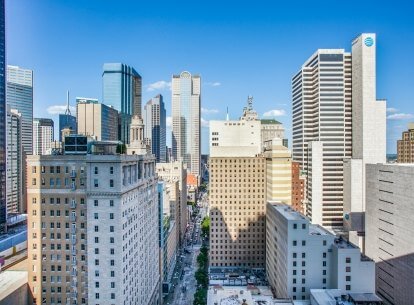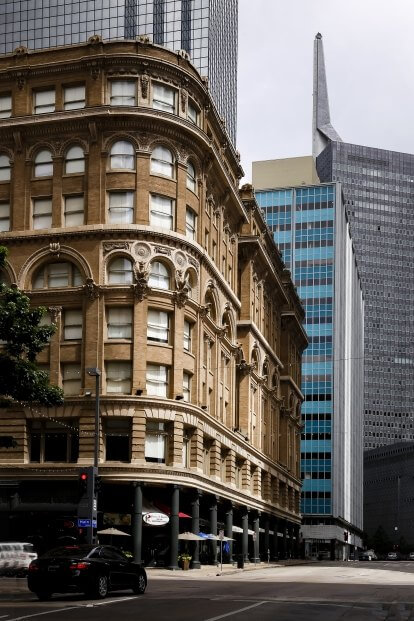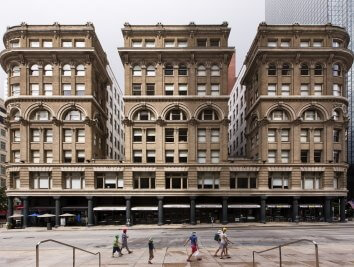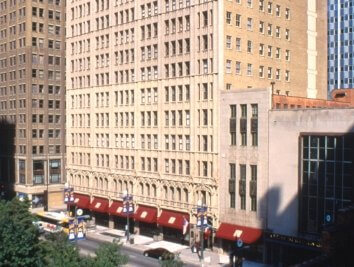From Cubicles to Home Sweet Home: The Art of Converting Offices into Apartments

Over the past 25 years, Corgan has designed an array of residential conversions in the Dallas-Fort Worth area. As the dialogue around conversions re-emerges, the firm is prepared to provide advice, expertise, and experience to developers and owners looking for a new lease on the life of older office stock.
Since the Covid-19 pandemic hastened in an era of remote and hybrid work, American cities suddenly have a surplus of empty offices that aren’t filling back up. With less demand for offices and more demand for housing, conversions are becoming more popular. While they may seem like a no-brainer, practical concerns stand in the way for many developers. There are risks and there are rewards. Corgan has developed a process and detailed checklist that we apply to each potential conversion to determine if the renovation makes financial and practical sense.
Challenge: Building Structure and Systems
Initial considerations are the basics like zoning, existing structure, building systems, parking, and loading. Since office buildings were not designed to be occupied 24/7, they lack the electrical and plumbing infrastructure that residential buildings require. Adding the necessary MEP is possible, but requires enough clearance between the floorplates to drop the ceiling. Commercial office buildings also don’t have HVAC systems that can be adjusted (or metered) per unit or individual circuit breakers for each unit. Likewise, office plumbing usually accommodates lots of bathrooms grouped together near the building’s core; residential plumbing needs to be spaced across each unit.
Challenge: Modern Preferences
A building’s footprint can be another hurdle for redevelopment. A large, deep floorplate is typical for an office: the center core is all elevators, bathrooms, and hallways that don’t need natural light or breezes. But residents want natural light, views, and cross breezes in their apartments. Because of this, older buildings that were built before the advent of central AC tend to be better candidates — they have more windows, shallower floorplates, and courtyards that maximize the number of windows per square foot, facilitating passive cooling and natural daylighting. Alternately, modern buildings with a long, skinny floorplate or a central courtyard can be viable candidates.
An example of this can be seen at The Metropolitan, an office to residential conversion that Corgan designed in 2005. A narrow floor plate made it cumbersome for office space, but ideal for residential use. To enhance the transition to residential, openings were cut into the existing curtain wall to allow private balconies with desirable views of downtown Dallas and the Trinity River. Corgan added a new six-story parking garage next door to solve the parking need for residents of The Metropolitan. The renovation included a beautiful amenity deck including a pool and spa, grilling stations and large roof deck for entertaining.

Benefit: Walkable Downtown
While office-to-residential conversions do come with practical and financial challenges, there can be significant payoffs. From a broader perspective, reinvigorating downtown cores with residential areas can help make them more “future proof,” since a multi-use area is more resilient to changes than a single-use area like a business district. Filling vacant or partially empty buildings also boosts the city’s property tax revenue, which can then be reinvested in the city and neighborhood, cutting short the “doom spiral” of urban decay.
A reinvigorated downtown also reflects (and reinforces) a shift in culture toward more walkable, livable downtowns. An example of this in Dallas is Klyde Warren Park (a highway deck park that connects downtown to uptown), which has made residents more aware of the benefits of walkability. The community benefits of the park also translate to economic benefits for developers: after the park was completed, rents in nearby neighborhoods increased from anywhere between 32% and 64%.

Corgan’s conversion of the formerly empty Wilson Building brought modern luxury apartments as well as street-level retail to downtown Dallas.
Benefit: History Renewed
Since early 1900s buildings tend to work well for conversions, they also offer the opportunity for developers to keep original features that lend historic charm to an otherwise new apartment. When converting the Wilson Building, Corgan retained the 1903 building’s original imported marble wainscoting, terrazzo floors, custom column capitals, door hardware, and carved stone wings. The allure of modern amenities mixed with historic details is a draw for many residents, but developers should also be aware of any historical or other special overlay districts. Historic buildings may also require the remediation of hazardous materials like lead or asbestos. Corgan works closely with local building departments and other stakeholders to help navigate these complex issues.
Conversions aren’t new, and neither are we
In the 25 years that Corgan has been designing office to residential projects a lot has changed, but the basics of a conversion are still the same: the right building, the right location, the right developer, and the right demographic demands are all important. From the intricacies of historical renovation to modern office conversions and repositioning projects, the firm has helped Dallas transform to support changing market needs, bringing new function and renewed life to outdated and underutilized facilities. As the commercial and residential markets changed over the years, Corgan has been there – not chasing trends, but remaining agile to serve our client’s needs and deliver projects that stand the test of time.










